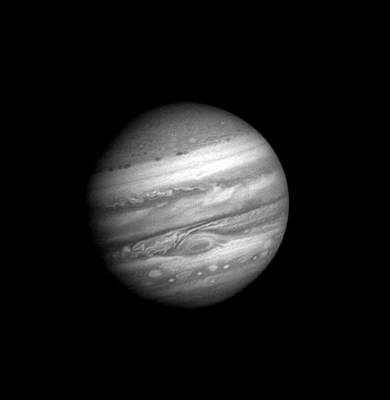Two of my favorite themes to estimate are space travel and green energy. I view the two as related. With population growth, I think the only way we’re going to maintain the planet is if some of us get off of it. (Some people should probably leave sooner than others.) With that said, I really like Thomas’s question from the comments below: “If we built a farm of giant wind turbines in Jupiter's Great Red Spot, how much energy could they provide?”
According to Wikipedia, the Great Red Spot has lasted for at least 180 years and possibly as long as 345 years. Its measures 24–40,000 km west–to–east and 12–14,000 km south–to–north. To make life easy, I’ll assume the Spot is a circle 20,000 km in diameter. Air currents flow around the edges with a maximum rate of 120 m/s (432 km/h). Jupiter’s surface pressure lies within the range 20-200 kPa and its average temperature is 125 K = -148°C. If we assume the atmosphere is an ideal gas1, we can compute the number density using the equation,
number density = (pressure) / [ (Boltzmann’s constant) · (temperature) ]
= (100 kPa) / [ (1.38×10-23 J / K) · (125 K) ]
= 6.0×1025 m-3.
This is the number density, i.e. the number of molecules in a cubic meter. Since most of Jupiter’s atmosphere is made of hydrogen gas, we can estimate the mass density by multiplying the number density by the mass of a single hydrogen molecule2,
mass density = (mass of H2) · (number density)
= (3.3×10-24 g) · (6.0×1025 m-3)
= 0.20 kg/m3.
Wind turbines convert the kinetic energy of the wind into electric energy. I’ll assume the turbine’s blades are 45 m long, so that they sweep out an area of 6,400 m2. We can estimate the energy produced by using the formula,
power = (density) · (area swept by the rotor) · (speed of the wind)3 / 2
= (0.20 kg/m3) · (6,400 m2) · (120 m/s)3 / 2
= 1.1×109 W
This is the total energy absorbed by the turbine, but not all of this will be converted into useable energy. If we assume the turbine is only 10% efficient, we’d end up with a total of 1.1×108 W per turbine. As the phrase “per turbine” suggests, this is how much energy we’d get from only one wind turbine. Wind farms usually have multiple turbines running simultaneously. If we rigged one up every 100 m in a circle around the edge of the Spot, we’d have a total of 630,000 turbines. We could then compute the total amount of useable power,
total power = (# of turbines) · (power per turbine)
= (630,000 turbines) · (1.1×108 W per turbine)
= 6.9×1013 W.
That’s enough energy to power 21 USAs. Although clearly an impractical solution to the energy problem, the sheer amount of energy makes it an intriguing option as an energy source. At the very least, it will hopefully make government officials think twice before slashing NASA’s budget.
Thanks, Thomas. This was a fun problem.
[1] Jupiter’s atmosphere is probably not an ideal gas, but this is a reasonable first estimate.
[2] You can calculate the mass of an H2 molecule by taking it molecular weight (~2.016 g/mol) and dividing by Avogadro’s number.


Is that Watts/hour or what? I never really understood the units of power.
ReplyDeletePower is a measure of how much energy you get per unit time. One Watt (or "W") is equal to one Joule of energy per second. For example, a 100 W bulb is using 100 Watts of power, which is equivalent to using 100 Joules of energy every second the bulb is on.
ReplyDeleteWell done. I would probably knock an order magnitude or two off that number simply because obviously wind turbines don't extract all the energy out of the wind.
ReplyDelete